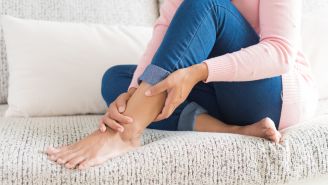Updated on July 14, 2023.
If you care for grandchildren full time, part time, or even for an occasional extended visit, you know it takes work to get prepared. That means stocking the refrigerator with favorite (nutritious) foods, loading up on books and toys, and making up bedrooms for peaceful sleep.
But there’s something even more important you need to do. It’s crucial to have the most up-to-date information about keeping kids safe and sound. Here’s what to know.
First aid, fever treatment, and medication
A 2020 study published in GrandFamilies: The Contemporary Journal of Research, Practice and Policy explored issues of first aid and fever treatment. Researchers polled 733 grandparents who identified as the primary caregiver of one or more grandchildren and found that a large percentage of the grandparents followed outdated health and safety practices.
For example, 64 percent of respondents believed that scrapes would heal better without a bandage. And when treating a fever, almost 40 percent thought an ice bath was the appropriate method.
In reality, the best method for treating minor scrapes and burns is to clean the wound with soap and water, apply antibacterial ointment, and cover with dry gauze or a bandage until it heals. That’s according to the American Academy of Pediatrics (AAP).
The AAP also states that the best treatment for fever is often no treatment at all.
If a fever is mild and the child is eating and drinking normally, sleeping well, and is still able to play, no treatment is necessary. If the fever is making the child uncomfortable or is accompanied by aches and pains, treatment may consist of taking acetaminophen or ibuprofen, consuming fluids, and wearing light clothes in a comfortable, cool room.
Above all, never give aspirin to children, and never use a cool bath or rubbing alcohol to treat fever, as these could cause serious side effects.
Needless to say, whether for fever or other illnesses, never give children medicine that is packaged for adults unless a healthcare provider (HCP) recommends it. That goes for cough and cold products in particular: Children under 4 years of age should not take them without guidance from an HCP, according to the Centers for Disease Control and Prevention (CDC).
Safe sleep practices
When it comes to putting children to bed—particularly toddlers and infants—it’s essential to know and follow the advice of leading medical organizations. Unfortunately, not all caregivers are aware of the latest best practices.
A 2017 study done by Northwell Health assessed the health beliefs of 636 grandparents. Almost one-quarter didn’t know that placing infants on their back in the crib reduced the risk of sudden infant death syndrome (SIDS).
Grandparents, and all caregivers, should follow safe sleep practices for infants, as recommended by the AAP. Infants should be placed on their backs in a crib or bassinet with a firm, flat mattress that's covered with a fitted sheet. The sleeping environment should be smoke-free with no other people or objects with them. Avoid setting an infant to sleep on a couch or chair, swing, or car seat. Do not allow stuffed animals, loose blankets, or bumpers in the sleep area.
The stakes are high when it comes to proper sleep practices: According to the AAP, improper sleep setups claim the lives of 3,500 infants every year.
Car seat guidelines
Grandparents who enjoy taking their grandchildren on outings should also stay up to date on the latest car seat regulations. This is critical, as car crashes are a leading cause of death in children in the United States, according to the CDC.
The AAP’s guidelines state that:
- Infants and toddlers should be placed in a rear-facing car seat until the age of two.
- Forward-facing car seats can accommodate children weighing up to 65 pounds, sometimes more. Review the manufacturer’s label for specifics.
- Belt-positioning booster seats may be used when a child reaches or exceeds forward-facing car seat weight or height limits.
- At around 4 feet, 9 inches in height and approximately 8 to 12 years old, car seats and boosters are no longer needed.
There's good reason to follow these tips: According to the CDC, the use of car seats reduces the risk of injury in crashes by up to 82 percent for children, compared to the use of seat belts alone. Booster seats reduce the risk of serious injury by up to 45 percent for kids ages 4 to 8, compared with seat belts alone. And for older children (and adults), seat belt use reduces the risk for death and serious injury by roughly half. Model good behavior for young ones by always wearing a seat belt when driving.
Lastly, remember that children 12 years and under should always ride in the back seat of a vehicle. While front passenger air bags can be lifesaving for adults, they may injure or even kill young children when they deploy in a crash.
With a little research into the latest guidelines—and possibly a few smart purchases—you can help ensure the health and safety of your grandkids while making lasting memories.







